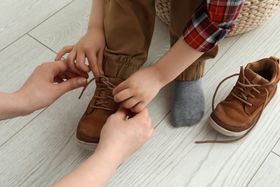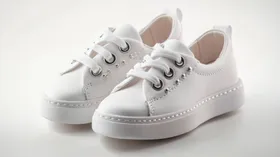Ankle Pain in Kids: Causes, Support & When to Worry
Most ankle pain in kids stems from normal causes like activity overuse, flat feet development, or growth spurts and resolves with rest and supportive care. However, persistent pain lasting weeks requires professional evaluation to rule out serious conditions.
Published October 31, 2025

Your child limps in from the playground, complaining that their ankle hurts. Or maybe they wake up at night saying their ankle aches, and you're trying to figure out if it's something you need to worry about or if it'll just go away on its own.
Now, ankle pain in kids is really common, especially if your child is active and growing fast. Most of the time, it goes away with rest and basic home care. But knowing the difference between normal growing pains and something more serious helps you make the right call for your child.
When Ankle Pain in Kids Is Totally Normal
1. Too Much Running Around Causing Ankle Pain in Kids
Think about how much your child moves in a day. Running, jumping, dancing, and even climbing at the playground. All that activity puts repeated stress on developing ankle joints.
When they do more than their growing body can handle right now, you get mild inflammation and tiny tears in muscles, tendons, and growth plates.
Symptoms of Ankle Pain Caused by Activity
If your child comes home after sports practice or a busy day at the park, complaining that their ankle hurts. The more they do, the more it hurts. But after resting, it feels better. You might notice your child limping a bit on really active days, but it disappears after some quiet time. The pain feels dull, not sharp.
This type of ankle pain kids get from doing too much usually goes away within a week or two if they rest enough. The trick is catching it early. If they keep playing through the pain, it takes longer to heal, and the inflammation gets worse.
How to Treat Kids' Ankle Pain Caused by Being Active
- At home, dial back whatever activity seems to be causing it. Maybe they do swimming or bike riding instead of running sports for a bit.
- Put ice on the sore spot for 15 minutes to bring down inflammation.
- Make sure they're wearing supportive shoes instead of regular shoes, with good cushioning when they're active.
To prevent it from happening again:
- Increase activity slowly instead of jumping into intense training suddenly.
- Watch for signs they're getting tired or starting to limp during play.
- Teach them how to land properly from jumps.
- Always warm up before and cool down after activities.
2. Flat Feet Causing Ankle Discomfort
Your child's feet are still developing until they're about 12 to 18 years old. The arches form between ages 4 and 12 [1]. During this time, if your child has flat feet or really flexible feet, it changes how their ankle works. This creates instability that stresses the joints, tendons, and everything around the ankle during activity.
Symptoms of Flat Feet-Related Pain
If your child tells you their ankle or the inside of their foot hurts after playing or walking around a lot. They might say their feet feel tired, especially after running on grass or sand. How much it hurts matches how long they were active, and it gets better when they rest.
This usually clears up within a week or two of taking it easy. As their foot muscles get stronger with age, the pain should gradually go away. Some kids need ongoing support from good shoes and might need to adjust how much they do.
How to Treat Kids' Ankle Pain Caused by Flat Feet
- Get shoes with proper arch support and ankle stability made for growing feet.
- Don't let them overdo it—build in recovery time between active play.
- Have them do ankle-strengthening exercises, flat feet exercises, and let them play barefoot safely to help their feet develop naturally.
To keep it from happening again:
- Watch how their feet are developing and deal with concerns early.
- Build up activity slowly with proper form and supportive shoes.
- Focus on activities that make ankles and feet stronger while avoiding too much pounding on hard surfaces.
3. Growing Pains in Ankles That Kids Get During Growth Spurts
During growth spurts, your child's bones shoot up faster than their muscles and tendons can keep up [2]. This creates tightness around the ankle joints. All that tension in growing tissues causes discomfort, especially when they're running around.
Symptoms of Growing Pains
Your child will probably describe an achy feeling around the back of their ankle and calf muscles, and they'll probably mention tightness too. It shows up after they've been active, and depending on how hard they played, it can be mild or pretty uncomfortable. Resting makes it better.
How long it lasts depends on your child, but it typically gets better as the growth spurt ends. If they rest and you use some of the home remedies, relief comes pretty quickly.
How to Treat Kids' Ankle Pain Caused by Growth Spurts
- Get them stretching their calf muscles gently every day to keep things from getting too tight as bones grow.
- A gentle massage feels good during these spurts.
- Make sure they warm up properly before activities and cool down after.
- Ease up on how much they're doing during rapid growth phases.
Prevention is the same as treating: regular stretching, taking it easier during growth spurts, good supportive shoes, and building up activity gradually instead of sudden increases.
When Ankle Pain in Kids Means Something More Serious
1. Growth Plate Injuries Causing Kids' Ankle Pain That Need Attention
Growth plates are the soft cartilage spots at the ends of bones that help them grow. While they're still open and growing, they're vulnerable to injury from all that physical activity [3]. Twisting or sudden forces can damage them. In bad cases, you get fractures that mess with normal growth.
Symptoms of Growth Plate Injuries
In this situation, your child will probably say their ankle hurts right after twisting or rolling it. They start limping and don't want to put weight on that foot. You will also see some swelling, or it's tender when you touch around the joint. It also hurts when they walk or go up stairs.
Expert Note: What makes these tricky is that sometimes the initial pain gets better after a few days, and you think everything's fine. But damage to the growth plate can still be there even when it doesn't hurt as much on the surface.
If your child had a significant twisting injury and they're still favoring that ankle even a little, or if the pain comes back when they get active again after seeming better, you need to get it checked. Growth plate injuries don't always show up dramatically. Sometimes the signs are really subtle.
If you don't treat a growth plate injury, it can cause the plate to close early and stop that bone from growing. This leads to one leg being shorter than the other, misaligned joints, and chronic instability. Catching it early prevents these serious problems down the road.
How to Treat Kids' Ankle Pain Caused by Growth Plate Injuries
- You'll need to see an orthopedic specialist.
- Your child might need a cast or boot to keep things stable, limited weight on that foot, and close watching.
- After that phase, physical therapy helps get the range of motion back and rebuild strength and balance.
2. Ankle Sprains That Need More Than Rest Causing Kids' Ankle Pain
Most minor sprains heal on their own, but some need attention. When your child twists or rolls their ankle, it overstretches the ligaments and causes inflammation right where it happened. Kids with flat feet or feet that roll inward too much are more likely to sprain their ankles.
Symptoms of Pain Caused by Ankle Sprains
The pain hits suddenly after they roll their ankle, usually on the outer side. You'll see some swelling, it's tender to the touch, and they're limping. It feels sharp and gets worse if they keep trying to play on it.
Most minor issues heal up in a week or two of treating a sprain at home. But the problem is that if they go back to playing before it's really healed, they can make the ligament damage worse. What started as a minor tear becomes a more serious injury that takes way longer to recover from.
How to Treat Kids' Ankle Pain Caused by Ankle Sprains
Treatment is pretty straightforward:
- Rest from whatever's bothering it.
- Ice and compression help with the swelling.
- Pain medicine can help with acute pain.
- Once the initial healing happens, gentle strengthening exercises help prevent it from happening again.
You can reduce the chances of this happening by watching what type of activities they're doing and whether they match their current fitness level.
Make sure they have enough rest, the right shoes, and the strength they need for whatever sport or activity they're into. Stretching and strengthening at home helps too.
3. Juvenile Idiopathic Arthritis Causing Ankle Pain in Kids
Juvenile idiopathic arthritis is a chronic condition where the immune system attacks the lining of the joints, causing inflammation, fluid buildup, swelling, and eventually damage to the cartilage in the ankle joint [4].
Symptoms of Juvenile Idiopathic Arthritis
With this issue, your child will have persistent ankle and leg pain, swelling, and will not move as much. They don't want to put weight on that ankle. The pain and stiffness are worse after they've been resting, in the mornings, or after naps. You notice them limping, especially after they've been sitting or sleeping for a while.
One confusing thing about this condition is that symptoms come and go. Your child might have several painful days, and then it gets better, so you think it's resolved. But this pattern of pain that keeps coming back, especially if mornings are stiff and it improves as the day goes on, is actually a classic sign of inflammatory arthritis, not simple overuse or growing pains.
The pain might also move between different joints or affect several areas at once. Don't brush off ankle pain that keeps returning just because it seems to go away temporarily.
Expert Note: Without treatment, you're looking at permanent joint damage, joints that can't move properly, early arthritis, and abnormal growth patterns.
It can affect other parts of the body, too, like the eyes, which can cause vision problems. Finding it early and managing it limits how much damage happens.
How to Treat Kids' Ankle Pain Caused by Juvenile Idiopathic Arthritis
Treatment needs a specialist and usually a whole team, including physical therapists. Medication manages the pain and stops the disease from progressing. Physical therapy keeps joints mobile, muscles strong, and your child able to do their normal activities throughout childhood.
When Pain Goes Away But Something's Still Wrong
Something I've noticed that confuses a lot of parents is that just because the pain stops doesn't always mean everything's fine. Some serious conditions have symptoms that come and go, which can trick you into thinking your child has recovered.
- Stress fractures, for example, might feel better after a few days of rest, but then the pain comes right back when they start playing again.
- Growth plate damage can seem minor at first, but cause problems months later when you notice something's off with how the bone is developing.
- Even sprains that seem healed can leave behind instability that makes future injuries more likely if you didn't finish proper rehab.
This is why watching for gait abnormalities and walking patterns matters just as much as watching symptoms. If your child keeps getting ankle pain in the same spot, even if each time it goes away, that pattern tells you something underlying is going on that needs professional eyes on it.
Same thing if the pain comes back quickly every time they resume activity despite getting adequate rest, that's more than simple overuse.
What to Know About Ankle Support for Kids
Ankle braces or taping can protect your child's feet while they heal, but you need to use them carefully. If your child wears support for too long, it weakens the stabilizing muscles, and they start relying on that external support. This actually increases the chance of getting hurt again once the brace comes off.
Only use ankle support during the healing phase and follow medical guidance on when to start phasing it out. The longer they wear it, the more it dulls their body's sense of where their ankle is in space, leaving them vulnerable once they take it off.
Moving Forward Without Worry
Most ankle pain in kids goes away on its own with rest, easing up on activities, and some basic care at home. Watch for the warning signs or pain that gets worse even though they're resting. Trust your gut, and if something feels off to you, getting it checked out is always the right move.
With proper orthopedic shoes, like First Walkers, they are specifically designed for growing feet, giving them the support, cushioning, and stability that developing ankles need.
Our orthopedic collection has firm heel counters and proper arch support that keep foot biomechanics healthy and take strain off ankle structures. For kids with flat feet or really flexible joints, this support helps prevent the ankle pain kids commonly get during active play.
References
Gould, N., Moreland, M., Alvarez, R., Trevino, S., & Fenwick, J. (1989). Development of the child’s arch. Foot & Ankle, 9(5), 241–245. https://doi.org/10.1177/107110078900900506
Osgood-Schlatter Disease. (n.d.). Nemours KidsHealth. https://kidshealth.org/en/parents/osgood.html
Mirtz, T. (2011b). The effects of physical activity on the epiphyseal growth plates: A review of the literature on normal physiology and clinical implications. Journal of Clinical Medicine Research. https://doi.org/10.4021/jocmr477w
Juvenile idiopathic arthritis - Symptoms and causes. (n.d.). Mayo Clinic. https://www.mayoclinic.org/diseases-conditions/juvenile-idiopathic-arthritis/symptoms-causes/syc-20374082
Disclaimer: First Walkers' information is intended for educational and informational purposes related to toddler footwear and feet. We encourage you to consider individual circumstances and consult qualified orthopaedists about specific conditions.
FAQs
Is ankle pain at night normal in growing kids?
Yes, growing pains in the ankles that kids experience often happen at night when muscles relax after being active all day. The aching usually affects both legs and gets better with gentle massage or stretching. If it's only one side, really severe, or there's swelling, check with your pediatrician.
When should I worry about my child's ankle pain?
Get it checked if the ankle pain lasts more than two weeks, only affects one ankle with swelling, happens after a specific injury, or comes with morning stiffness lasting over six weeks. Pain that stops them from walking or gets worse even with rest also needs evaluation.
Can flat feet cause ankle pain in kids?
Yes, flat feet change how the ankle works and reduce shock absorption, which creates strain on ankle joints and tendons when they're active. This commonly causes the ankle pain kids with flat feet get after playing or standing for a long time.
What shoes help prevent ankle pain in active kids?
Shoes with firm heel counters, proper arch support, good cushioning, and flexible soles help prevent ankle pain kids get during activities. The shoes should fit right with room to grow, while still giving them stability when they move.







